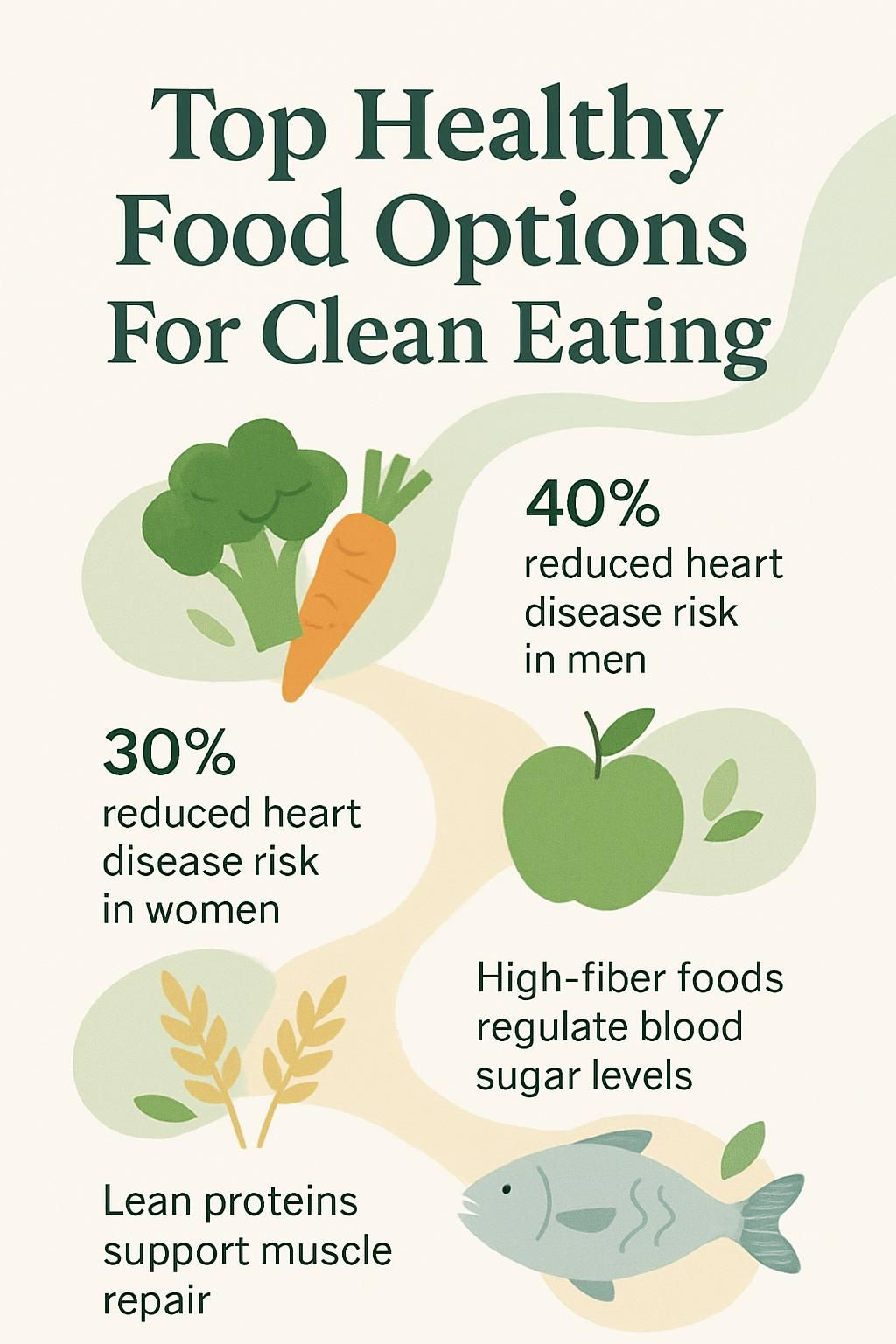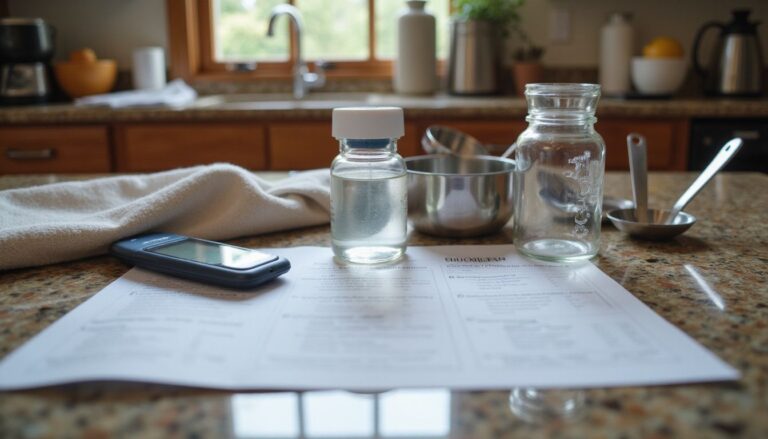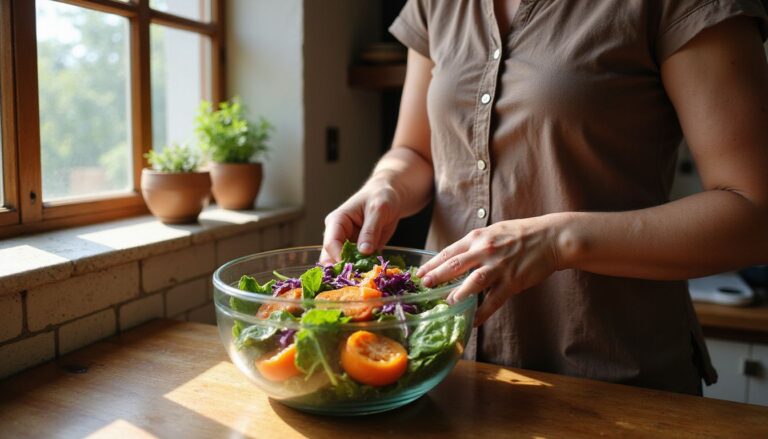Top Healthy Food Options For Clean Eating
Our Nutrition Assistant AI Suite will transform your body. You will lose fat, get toned, and build muscle. Gain confidence and optimal health.
Healthy eating feels easier when I know which foods to choose and why they help. Many people share this goal, yet the choices can feel crowded. A focus on nutrient-dense whole foods, plus simple habits, supports long-term health and lowers risk for chronic disease.
In this guide, I highlight practical clean eating picks, explain the science in plain language, and offer steps you can use today. These ideas build a balanced diet and make daily meals simpler and more satisfying.
Key Takeaways
- Clean eating centers on whole, minimally processed foods, such as fruits, vegetables, nuts, legumes, lean proteins, and whole grains. This pattern relates to lower chronic disease risk (Harvard Healthy Eating Plate, 2020).
- Higher scores on healthy diet indexes are linked with less heart disease. Men showed up to 40 percent lower risk and women up to 30 percent versus low-fat diet scores (Alternate Healthy Eating Index).
- High-fiber choices like oats and chia seeds aid digestion, support weight control, and steady blood sugar levels (USDA FoodData Central; Harvard T.H. Chan School of Public Health).
- Lean proteins, including chicken breast, eggs, and salmon, supply essential amino acids for muscle repair without much saturated fat.
- Eating nutrient-dense foods from each food group, as outlined in the Dietary Guidelines for Americans, supports heart health, immunity, and daily energy.

What is Clean Eating?

Clean eating means I choose foods close to their natural form. I focus on whole grains, fresh fruits and vegetables, lean meats or fish, and foods low in added sugar and saturated fat.
What does clean eating mean?
For me, clean eating is simple. I pick whole foods most of the time, such as produce, beans, nuts, seeds, eggs, poultry, and seafood. I limit highly processed items that add sugar, sodium, dyes, or preservatives.
The Healthy Eating Plate from Harvard guides my plate. I use healthy oils like olive oil or avocado oil and drink water instead of sweetened beverages. I swap refined grains for intact whole grains and keep fried potatoes rare since they can spike blood sugar.
I aim for variety across food groups to cover vitamins, minerals, and dietary fiber. I also favor low-fat or fat-free dairy products to reduce saturated fat, a step many heart groups endorse, including the American Heart Association.
As I shop, I read labels. I watch for added sugars and salt, which often hide in packaged foods. This aligns with the 2020 to 2025 Dietary Guidelines for Americans from the United States Department of Agriculture.
The core idea is clear: eat more foods from nature, fewer foods from factories.
Why is clean eating important for overall health?
Clean eating helps protect the heart and supports a healthy weight. Research from Harvard shows that people with higher-quality diet patterns had far less heart disease risk than those following low-fat scores alone. Other studies link clean eating with lower total mortality over time.
Fruits, leafy greens, cruciferous vegetables like broccoli, nuts, whole grains, and lean proteins improve energy and digestion. High fiber, found in foods like oats, beans, and berries, also helps manage cholesterol and blood pressure. This supports heart health and lowers the chance of type 2 diabetes and hypertension later in life.
Benefits of Clean Eating
Clean eating gives my body steady fuel and key nutrients. I feel better during the day, and my meals stay simple and satisfying.
How does clean eating improve energy levels?
Whole grains, such as brown rice and oats, give slow and steady energy. These carbohydrates digest gradually, which helps prevent mid-morning energy crashes.
Produce and nuts add vitamins and minerals that support energy production. For example, quinoa is rich in magnesium, a mineral that helps convert food into energy.
I include protein at each meal from eggs, chicken, or tofu. Healthy fats from extra-virgin olive oil or avocado oil help stabilize blood sugar and keep energy even. I also choose water over sweet drinks since dehydration can sap energy, as noted by Harvard clinicians.
How does clean eating enhance digestion?
Fiber is the hero for gut health. Beans, lentils, oats, and other whole grains promote regularity and feed friendly gut bacteria. Oats provide beta-glucans, a type of soluble fiber that supports the gut lining.
I like adding yogurt with live cultures for probiotics, which are helpful bacteria. Chia seeds deliver almost 10 grams of fiber per ounce and support regular digestion. Vegetables like broccoli and kale supply fiber plus minerals that keep the digestive process moving.
Soaking legumes before cooking often reduces gas and discomfort. I also drink enough water so fiber can do its job well.
How does clean eating support weight management?
High-fiber foods help me feel full. Leafy greens, carrots, beans, and whole grains like brown rice or oats curb overeating by slowing digestion. I keep added sugar low and pick foods and drinks that do not pile on empty calories.
Nuts such as almonds and peanuts satisfy hunger in small portions. Healthy fats from olive oil and avocado can aid fullness and reduce snacking, even though they are high in calories.
Swapping white bread and salty snacks for minimally processed options helps me eat less salt and more nutrients. MyPlate’s portion tips keep my plate balanced, which makes it easier to avoid eating too much.
| Food Type | Key Benefit | Example |
|---|---|---|
| Whole grains | Good source of fiber | Oats, brown rice |
| Nuts and seeds | Support fullness | Almonds, peanuts |
| Lean proteins | Filling with less fat | Chicken breast, eggs |
| Healthy fats | Appetite control | Olive oil, avocado |
Eating more vegetables, like celery and tomatoes, in place of highly processed foods supports heart health. I have seen steady progress with these choices, without crash diets.
How does clean eating reduce the risk of chronic diseases?
Clean eating delivers nutrients that help quiet inflammation, a driver of many chronic conditions. Fruits, vegetables, fish, legumes, and whole grains supply fiber and vitamins A and C, which protect cells and support immunity.
Studies link higher Healthy Eating Index scores with less heart disease over the long term. Salmon offers omega-3 fats that support heart health. Beans and lentils help steady blood sugar. Dark leafy greens add potassium, which can reduce high blood pressure.
Limiting saturated fat from butter and full-fat cheese while using unsaturated fats, such as olive oil, further supports the heart. Together, these habits lower the risks tied to cardiovascular disease, diabetes, and some cancers.
Top Healthy Food Options for Clean Eating
I reach for foods that deliver big nutrition in simple portions. Think of this as a clean pantry plan you can rely on day after day.
Fruits and Berries
Fruit needs little prep and packs plenty of fiber and vitamins. Apples, bananas, oranges, strawberries, and blueberries are easy to add to cereal, yogurt, or salads.
A medium apple has about 4 grams of fiber with fewer than 100 calories. Blueberries are rich in antioxidants and provide vitamin C. Avocados are a special case since they offer healthy fat, fiber, and potassium that support heart health.
I rotate fruits to keep meals interesting and cut my urge for sugary snacks. Kiwi, mango, pears, plums, and grapes keep the week colorful and tasty.
What are the benefits of apples for clean eating?
Apples are portable and do not need cooking. One medium apple provides around 4 grams of fiber for digestion and fullness, along with vitamin C for immune support.
Natural antioxidants in apples are linked with a lower risk of heart disease. Their sweet taste replaces many processed snacks with added sugar. I slice apples over oatmeal or toss them into salads for crunch and fiber.
Why include blueberries in a clean eating diet?
Blueberries are rich in antioxidants, which protect cells from damage. They are low in calories and high in vitamin C, vitamin K, and manganese.
I add blueberries to yogurt or salads. Their sweetness helps me skip added sugar at breakfast. Regular blueberry intake is linked with healthier hearts and better blood sugar control over time.
How do oranges contribute to clean eating?
Oranges supply vitamin C for immune health and antioxidants that reduce inflammation. A medium orange has about 3 grams of fiber, which helps me stay full between meals.
They are low in calories and high in water, which supports hydration. I often use orange segments in salads to replace sugary dressings.
What makes avocados a healthy choice?
Avocados offer heart-friendly monounsaturated fats that can replace saturated fat from spreads like butter. Each serving adds fiber and potassium, which helps support healthy blood pressure.
They also contain vitamin C and help the body absorb fat-soluble vitamins from vegetables. I use mashed avocado on sandwiches or blend it into dressings to add creaminess without added sugar.
Vegetables
Vegetables form the base of my clean meals. I mix colors and types to cover more nutrients:
- Broccoli, a cruciferous vegetable, brings fiber, vitamin C, vitamin K, and some protein.
- Kale is packed with fiber and high levels of vitamins C and K.
- Carrots supply beta carotene for eye health, plus vitamin K and fiber.
- Bell peppers add bright color, crunch, and lots of vitamin C.
- Asparagus is low in calories and a good source of vitamin K.
- Mushrooms and cabbage add minerals and savory depth to meals.
- Brussels sprouts, artichokes, celery, eggplant, leeks, lettuce, radishes, squash, zucchini, and turnips keep my plate varied.
Rotating choices each week helps me meet mineral needs and avoid boredom. This approach keeps me on track with a clean, nutrient-dense plan.
Why is broccoli good for clean eating?
Broccoli is low in calories and high in fiber. One cup gives about 3 grams of plant-based protein with fewer than 35 calories. That combo supports weight goals and steady digestion.
It also provides vitamins C and K and useful antioxidants. I eat it raw with hummus, steam it, or roast it with olive oil for a simple side.
How does kale support clean eating?
Kale is one of the most nutrient-dense leafy vegetables. One cup has about 33 calories and nearly 3 grams of fiber. That is great for satiety and digestive health.
A single serving delivers over 100 percent of daily vitamin C and K needs. Those vitamins support immunity and bone health. I toss kale into salads, sauté it, or bake kale chips for a crisp snack.
What are the health benefits of carrots?
Carrots help me manage hunger and supply fiber for gut health. They add vitamin K for bones and beta carotene for skin and eye health.
I keep carrot sticks in the fridge for fast snacks or dip them in hummus. They are budget-friendly, easy to store, and work raw or cooked.
Why include bell peppers in your diet?
Bell peppers are rich in antioxidants and vitamin C, which supports immune function and iron absorption. Carotenoids in peppers also support eye health.
A medium pepper has about 30 calories, which makes it great for weight goals. I add peppers to salads, stir-fries, or omelets. They keep their nutrients well with light cooking.
Including fresh vegetables like bell peppers has boosted both my energy and digestion.
1) U.S. Department of Agriculture FoodData Central: https://fdc.nal.usda.gov/fdc-app.html#/food-details/169910/nutrients
2) Harvard T.H. Chan School of Public Health – Vegetables & Fruits: https://www.hsph.harvard.edu/nutritionsource/what-should-you-eat/vegetables-and-fruits/.
Nuts and Seeds
Nuts and seeds make clean snacking easy. Almonds, walnuts, Brazil nuts, and chia seeds deliver fiber, protein, and healthy fats that help keep me full.
Almonds add vitamin E and magnesium. Chia seeds bring almost 10 grams of fiber per ounce. Walnuts supply plant omega-3 fats. Brazil nuts are an excellent source of selenium, which supports thyroid function.
Though calorie-dense, these foods are linked with better weight control and heart health. I use small portions to enjoy their benefits without overdoing calories or salt.
What are the benefits of almonds?
Almonds provide vitamin E, a powerful antioxidant. One ounce gives about 7 milligrams of vitamin E and 76 milligrams of magnesium, which supports muscle and nerve function.
Their fiber helps digestion and fullness. Research links almond intake with improved heart markers and weight management. I sprinkle almonds over yogurt or salads or use unsalted almond butter on whole-grain toast.
Why eat chia seeds for clean eating?
Chia seeds deliver 9.75 grams of fiber in a 28-gram serving. They also supply omega-3 fats that support heart and brain health and a modest amount of protein for muscle repair.
I stir chia into smoothies or oatmeal. When soaked, they form a gel that may aid hydration and regularity. Their antioxidants help reduce oxidative stress in the body.
How do walnuts fit into a clean eating plan?
Walnuts bring fiber, minerals like magnesium and copper, and plant omega-3 fats. They support heart health and may help lower LDL cholesterol.
I add walnuts to salads or grain bowls without extra sugar or salt. Their nutrient density makes them a smart choice for a clean plan.
¹ Data: U.S. National Library of Medicine (2022): Walnuts may lower LDL cholesterol by approximately 9 to 16 percent when included regularly in diets replacing saturated fat sources; calories per ounce: 185; fiber: about 2 grams; ALA Omega-3 fatty acids: 2.5 grams per ounce
What makes Brazil nuts a healthy option?
Brazil nuts stand out for selenium, a mineral essential for thyroid and antioxidant defenses. One to two nuts can meet daily selenium needs for most adults.
They also supply magnesium, zinc, protein, and healthy fats. I keep portions small due to the high selenium content. Chopped Brazil nuts add crunch to salads with cucumber or grain bowls.
Whole Grains
Whole grains deliver fiber, B vitamins, and minerals that refined grains lack. I rely on quinoa, brown rice, and oats to build satisfying meals that support heart health.
Quinoa offers complete protein for plant-based eaters. Brown rice has more fiber and minerals than white rice. Oats help lower cholesterol due to beta-glucans, a soluble fiber.
Sprouted whole-grain breads, such as Ezekiel, can add variety. I also look for homemade or low-sugar loaves that keep fiber high and ingredients simple.
Why choose quinoa for clean eating?
Quinoa is a high-fiber grain that also provides complete protein, meaning all nine essential amino acids are present. A cup of cooked quinoa has about 5 grams of fiber and helpful minerals like magnesium.
It cooks in roughly 15 minutes and works warm or cold. Quinoa is gluten free, which is helpful for people with sensitivities.
How does brown rice support a clean diet?
Brown rice keeps the bran and germ layers, so it retains fiber and minerals like thiamine and magnesium. This supports digestion, steady energy, and healthy nerves and muscles.
The complex carbs in brown rice help maintain stable blood sugar. Its higher fiber supports fullness, which can aid weight control.
I pair brown rice with vegetables, lean proteins, and healthy fats for balanced meals.
Harvard T.H. Chan School of Public Health – Whole Grains.
What are the benefits of oats?
Oats supply vitamins, minerals, and beta-glucans, which help lower LDL cholesterol and support gut health. They offer steady energy and work well for breakfast or baking.
Oats are minimally processed, and certified gluten-free options exist for those who need them. Their soluble fiber can help regulate blood sugar and improve fullness.
Lean Proteins
Lean proteins help maintain muscle, support metabolism, and keep me satisfied. I build meals around lean beef, chicken breast, eggs, salmon, and plant proteins like lentils or beans.
Grass-fed lamb can add omega-3 fats. Kidney beans are nutrient rich but must be cooked well. Peanuts make a smart snack due to protein and fiber that tame hunger.
Why is chicken breast recommended?
Chicken breast is low in fat and high in protein. About 100 grams delivers 31 grams of protein, which supports muscle repair and maintenance.
It also provides B vitamins like niacin and vitamin B6. I grill, roast, or stir-fry chicken breast to keep processing minimal and ingredients clean.
How does salmon support clean eating?
Salmon provides high-quality protein and omega-3 fats, including EPA and DHA. These fats support heart and brain health and help reduce inflammation.
A 3-ounce serving gives about 22 grams of protein plus vitamin D for bone health. I choose wild-caught or responsibly farmed salmon and cook it by baking or grilling.
Eggs are another excellent protein to add next.
What makes eggs a good clean eating protein?
Eggs deliver complete protein in a convenient package. They also provide vitamin B12, vitamin D, selenium, and choline for brain function.
Recent research suggests eggs fit well in a balanced diet for most people. I keep hard-boiled eggs ready for quick breakfasts and snacks.
Why include lentils in your meals?
Lentils are rich in fiber and plant protein, which makes meals filling without much saturated fat. They add iron, folate, and potassium, nutrients that many diets lack.
Soaking beans and cooking lentils until tender improves digestion. I use lentils in soups, salads, and grain bowls for easy, budget-friendly meals.
Healthy Fats
Healthy fats help me absorb vitamins and stay satisfied. I rotate extra-virgin olive oil, avocado, nuts, and fatty fish like salmon or sardines for omega-3s.
Replacing butter or hydrogenated oils with these options supports heart health and flavor. Small amounts go a long way at meals.
Why use extra-virgin olive oil?
Extra-virgin olive oil is rich in monounsaturated fat and antioxidants. Regular use is linked with better heart outcomes and lower inflammation.
I drizzle it on salads or use it in sautés at moderate heat. It adds flavor while keeping my ingredient list simple and clean.
What are the benefits of coconut oil?
Coconut oil contains medium-chain triglycerides, a type of fat that the body can use for energy. It has a distinct flavor that works well in some dishes.
Because it is higher in saturated fat than olive oil, I use coconut oil sparingly. It fits a clean plan when used in moderation and without additives.
How does avocado oil fit into clean eating?
Avocado oil is high in monounsaturated fat and vitamin E. It has a high smoke point, which makes it useful for roasting and sautéing.
It also helps the body absorb fat-soluble vitamins A, D, E, and K from vegetables. I use it as a neutral cooking oil or in simple vinaigrettes.
Tips for Incorporating Clean Eating into Your Lifestyle
Small actions build steady progress. I use simple routines that make clean choices the easy choices in my day.
How can meal planning help clean eating?
Planning meals saves time and reduces last-minute fast food choices. I pick a few staples, such as apples, blueberries, broccoli, chicken breast, and brown rice, and plan around them.
I portion snacks like almonds or chia seed pudding into containers for quick grabs. I also cook grains in batches for easy lunches. A registered dietitian once helped me fine-tune my plan to match my health goals.
Why choose minimally processed foods?
Minimally processed foods keep more vitamins and minerals. They usually skip additives, dyes, and artificial flavors.
Fruits, vegetables, whole grains, nuts, and seeds form the base of my clean meals. These choices help me manage sodium and added sugar while supporting long-term health.
How to read food labels effectively?
I start with serving size, since all numbers depend on it. Short ingredient lists with familiar names are a good sign.
I scan for added sugars and sodium. If sugar or salt ranks near the top, I look for a better option. I compare calories, protein, fiber, and key vitamins to pick the stronger choice.
Why is staying hydrated important for clean eating?
Water supports digestion, nutrient absorption, and body temperature. It also helps control appetite and keep energy steady.
I aim for water with each meal and add water-rich foods like oranges and bell peppers. That extra fluid helps my body use the nutrients in clean foods.
Conclusion
Clean eating gives me steady energy, better digestion, and support for weight goals. Whole grains, fruits, vegetables, nuts, seeds, lean proteins, and healthy oils create a strong base for health. These healthy foods align with the Dietary Guidelines for Americans and support heart health over time.
Simple steps, done often, lead to meaningful change. If you have a medical condition or special dietary needs, consider speaking with a healthcare professional or a registered dietitian for personalized guidance.
Healthy eating is a daily practice I can trust. Each clean choice makes the next one easier.
FAQs
1. What are the best healthy food options for clean eating?
Whole grains, leafy greens, lean meats like chicken or turkey, and legumes such as beans provide key nutrients with minimal processing. Fresh fruits and vegetables offer fiber and vitamins that support overall health.
2. How do I know if a food is suitable for clean eating?
Foods with few ingredients and no added sugars or artificial additives fit well into a clean eating plan. Reading nutrition labels helps identify whole foods high in protein, fiber, and essential minerals.
3. Are there scientific benefits to choosing these healthy foods?
Studies show diets rich in whole grains, vegetables, fruits, and lean proteins can lower cholesterol levels by up to 10 percent while reducing risk of heart disease (Harvard T.H. Chan School of Public Health). High-fiber diets also improve digestion according to research from the Mayo Clinic.
4. Can you share an example of applying clean eating in daily life?
Last year I replaced sugary snacks with apple slices topped with peanut butter during work breaks; this simple change increased my energy levels throughout the day without causing sugar crashes.
Summary: Clean eating focuses on nutrient-dense foods like whole grains, fresh produce, lean meats such as poultry or fish, and legumes including lentils or chickpeas. Choosing minimally processed items supports better health outcomes based on current evidence from leading nutrition studies.







